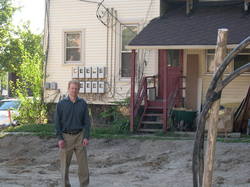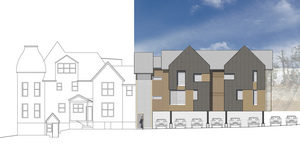Source: www.annarbor.com
Packard Road rental home aims to be first LEED-certified student housing in Ann Arbor
 A 1901-era home at Packard near Hill could become the first LEED-certified private student housing in Ann Arbor after an addition and renovation that includes installation of a geothermal heating and cooling system.
A 1901-era home at Packard near Hill could become the first LEED-certified private student housing in Ann Arbor after an addition and renovation that includes installation of a geothermal heating and cooling system.
Owner Warren Samberg and builder Bloom General Contracting will seek Gold-level certification under the U.S. Green Building Council's Leadership in Energy and Environmental Design program, which measures sustainable building practices.
Samberg, a LEED accredited architect who did the plans himself, said the green construction would help attract students to his property, be more environmentally sensitive, and pay for itself within nine to 11 years.
"Some of it is costly," he said. "Probably the geothermal is the most costly. Everything else isn't much more (than conventional building practices)."
"I do expect LEED certification to help with marketing, since many Michigan students are embracing a green lifestyle," he added.
Samberg declined to disclose the budget for the project. Work on installing the geothermal system has begun, and the foundation for the addition, which will add 12 new beds to the 11 existing ones, will be laid within weeks. The hope is to finish by February, Samberg said.
 Al Bloom of Bloom General Contracting said Samberg is going above and beyond with some of the green practices in the project, such as installing recycled wood louvers on the exterior to shade the windows.
Al Bloom of Bloom General Contracting said Samberg is going above and beyond with some of the green practices in the project, such as installing recycled wood louvers on the exterior to shade the windows.
"What's neat about it is he's done a few extra features he didn't have to do," Bloom said.
He also said existing student housing is going to have to be upgraded to keep pace with the new amenity-filled high-rises such as Zaragon Place.
"Prom that point of view, existing property owners are going to have to change ... to have more desirable spaces," he said.
Along with the geothermal system and recycled wood on the exterior, green features in the project include the use of Forest Stewardship Council-certified wood, bamboo (which is a more renewable material than wood), low VOC (volatile organic compound) paint, a light-colored metal roof to reflect heat, placement of windows to maximize sunlight, and a storm-water management system that includes a rain garden. The addition will also be built so that six to eight parking spaces will fit underneath the living areas.
Increasing density in the neighborhood by addition rather than demolishing the existing structure also is an important sustainable practice, Samberg said.
He said that's the "greenest approach" architects, builders and owners can take.
Bloom claims the project will be the city's first LEED-certified student housing. The USGBC Web site lists 15 building projects in town that are either certified or pending. Most are commercial structures; two are single-family homes; and one, Tierra on Ashley, includes a multi-unit residential component. That project has city approval but has not begun construction.
A group of U-M students have been active in pushing the university toward a green building standard, but university officials have leaned more toward practices that minimize ongoing energy use rather than LEED certification.
LEED recently changed its system to integrate ongoing monitoring of the energy use of certified project. A recent report in the New York Times documents the relatively high energy usage of some LEED-certified buildings.
Photo by Dan Meisler | Owner Warren Samberg stands behind his 1901 student rental home, where a 12-bed addition will be built. In the foreground is part of the installation of a geothermal heating and cooling system.
Drawing | An artist's rendering of the project.
Freelance reporter Dan Meisler can be reached at danmeisler@gmail.com.